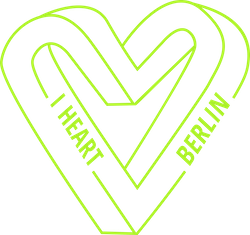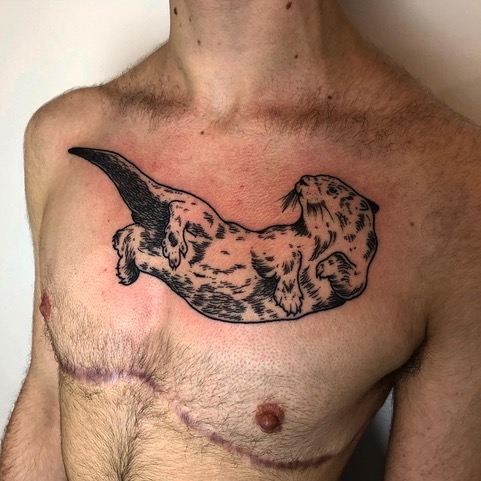In the 24h+ parties, people from all walks of life express themselves freely and expansively. Everybody can exist, take up space, and move however they feel comfortable.
What is perhaps not so widely known is that tattoos are also a fundamental part of the queer expression in Berlin. The open-minded character of the city, added to a vibrant and diverse international community, proved perfect for a prolific queer tattoo scene to thrive.
Many studios that aim to be safe(r) spaces have opened all over the city, allowing artists from around the world to settle here and develop their own styles. The scene has grown exponentially in the last 5 years and in 2019 the very first tattoo event showcasing only queer talent happened in the city.
Queer Tattoo Convention
The tattoo artist Ina Bär a.k.a. Bearadise Ink spent 3 years envisioning a space for queer tattoo artists to connect, share knowledge, and spread love but couldn’t find the right venue for it. It finally happened in September 2019, after she got connected to the venue SO36 through a tattoo appointment. The space, famous for being a place of cultural resistance that stands against all types of discrimination, was a good location.
The first Queer Tattoo Convention came together in under 2 months, attracting more than 400 guests. “People were literally crying and some got their first tattoos done there. Everyone was super busy and nearly 100 tattoos were done that day with a lot of follow-up appointments.” Ina says.
A second edition of the convention is in the plans for when big gatherings are possible again. “Hopefully for next year, we will be able to have a 2-day event with more artists, performances, vendors, and queerness of course!”
Queer Ink
Queerness and tattoos have become interwoven in the last decades but the connection between the two is still up for debate even within the scene. Martin Jahn, artist tattooing at Trade Mark, believes tattoos are bigger than just one group of people, “tattoos are for everybody.”
Fercha Pombo, who tattoos at their own private home studio, explains that “tattoos have existed in different cultures around the world for a really long time, mostly to say things about people’s occupation or ancestry.”
As with most rituals and art forms that have been around for long stretches of time, the practice of committing ink to skin seems to have taken different connotations lately. “Adorning one’s body with tattoos can be part of breaking free from destructive heteronormative capitalist beauty standards.” weighs in Sven Eigengrau, resident at TTTRIP Tattoo.
This perspective is also shared by people who are on the receiving end of the process. Lea Rose, 20+ tattoos and counting, believes that “tattoos are a way of taking ownership of my body. Using tattoos to express and embrace queerness in a society that decided you are different anyway can be really empowering.”
The ‘No Style’ Aesthetic
The city that nourishes so many unique forms of self-expression also makes for the perfect environment for a wide range of styles to thrive. According to Florian Hirnhack, owner and resident at TTTRIP, Berlin’s “a place with a high demographic exchange and many individuals gathering and where different opinions evolve so it’s a great place for artists and results in a style pluralism”.
It’s only natural that such a stimulating context would have an impact on the work of tattoo artists. Rio adds that “the tattoo scene in Berlin is exciting because there are so many people coming and going all the time, leaving their mark and shaping the community. It’s always changing, always in transition”.
Safe(r) Space
One thing all of them can agree on is the importance of creating a safe(r) container for the tattoo experience. There are different ways to create a welcoming environment, and they all involve more individualized attention to the person getting a tattoo.
The next step is the first contact and booking, which also factor in the overall experience. For Sven, attention to the stage that precedes the tattoo means a pronoun section in the booking form and showcasing a variety of body types when designing placement proposals.
“Trade Mark is not a street shop, which means no walk-ins so people can get comfortable and experience the tattoo as something special,” explains Martin “with no other people watching you, you can be yourself.”
***
Text: Bruna Corsato

Auf den tagelangen Partys können sich Menschen aus allen Gesellschaftsschichten frei und ungezwungen ausdrücken. Jeder kann so existieren, Raum einnehmen und sich bewegen, wie es ihm gefällt.
Was vielleicht nicht so weit bekannt ist, ist, dass Tätowierungen auch in Berlin ein grundlegender Bestandteil des queeren Ausdrucks sind. Der aufgeschlossene Charakter der Stadt, der zu einer lebendigen und vielfältigen internationalen Gemeinschaft beiträgt, erwies sich als perfekt für das Gedeihen einer produktiven queeren Tätowierszene.
Viele Studios, die sich als Safer(r) Spaces verstehen, haben überall in der Stadt eröffnet, so dass sich Künstler aus der ganzen Welt hier niederlassen und ihre eigenen Stile entwickeln konnten. Die Szene ist in den letzten 5 Jahren exponentiell gewachsen, und 2019 fand in der Stadt die allererste Tätowierveranstaltung statt, bei der ausschließlich queere Talente vorgestellt wurden.
Queer Tattoo Convention
Die Tätowierkünstlerin Ina Bär verbrachte 3 Jahre damit, sich einen Raum für queere Tätowierer vorzustellen, in dem sie sich verbinden, Wissen austauschen und Liebe verbreiten können, konnte aber nicht den richtigen Ort dafür finden. Es geschah schließlich im September 2019, nachdem sie durch einen Tätowiertermin mit dem Veranstaltungsort SO36 in Verbindung gebracht wurde. Der Raum, der dafür berühmt ist, ein Ort des kulturellen Widerstands zu sein, der gegen alle Arten der Diskriminierung steht, war ein guter Ort.
Die erste Queer Tattoo Convention fand nach weniger als 2 Monaten statt und zog mehr als 400 Gäste an. “Die Leute weinten buchstäblich, und einige ließen sich dort ihre ersten Tätowierungen machen. Alle waren super beschäftigt, und an diesem Tag wurden fast 100 Tätowierungen gemacht, mit vielen Folgeterminen”, sagt Ina.
Eine zweite Auflage ist in Planung, wenn wieder große Zusammenkünfte möglich sind. “Hoffentlich können wir nächstes Jahr eine zweitägige Veranstaltung mit mehr Künstlern, Auftritten, Verkäufern und natürlich Queerness durchführen!
Queere Tinte
Queerness und Tattoos haben sich in den letzten Jahrzehnten verwoben, aber die Verbindung zwischen beiden steht auch innerhalb der Szene noch zur Debatte. Martin Jahn, Tätowierkünstler bei Trade Mark, glaubt, dass Tätowierungen größer sind als nur eine Gruppe von Menschen, “Tätowierungen sind für alle da”.
Fercha Pombo tätowiert im eigenen privaten Heimstudio und erklärt, dass “Tätowierungen in verschiedenen Kulturen auf der ganzen Welt seit sehr langer Zeit existieren, meist, um Dinge über den Beruf oder die Abstammung der Menschen auszudrücken”.
Wie bei den meisten Ritualen und Kunstformen, die es schon seit langer Zeit gibt, scheint die Praxis, Tinte auf die Haut zu tätowieren, in letzter Zeit andere Konnotationen angenommen zu haben. “Seinen Körper mit Tätowierungen zu schmücken, kann ein Teil der Befreiung von destruktiven heteronormativen kapitalistischen Schönheitsidealen sein”, meint Sven Eigengrau, der bei TTTRIP Tattoo arbeitet.
Diese Perspektive wird auch von Menschen geteilt, die sich auf der Empfängerseite des Prozesses befinden. Lea Rose, 20+ Tätowierungen und mehr, glaubt, dass “Tätowierungen eine Möglichkeit sind, Besitz von meinem Körper zu ergreifen”. Die Verwendung von Tätowierungen, um in einer Gesellschaft, die beschlossen hat, dass man ohnehin anders ist, Queerness auszudrücken und zu umarmen, kann wirklich bestärkend sein”.
Die ‘Kein Stil’-Ästhetik
Die Stadt, die so viele einzigartige Formen des Selbstausdrucks nährt, bietet auch die perfekte Umgebung, in der eine Vielzahl von Stilen gedeihen kann. Laut Florian Hirnhack, Eigentümer und Resident bei TTTRIP, ist Berlin “ein Ort mit einem hohen demografischen Austausch und vielen Individuen, an dem sich viele Menschen treffen und an dem sich unterschiedliche Meinungen entwickeln, so dass es ein großartiger Ort für Künstler ist und zu einem Stilpluralismus führt”.
Es ist nur natürlich, dass sich ein solch stimulierender Kontext auf die Arbeit von Tätowierkünstlern auswirken würde. Rio fügt hinzu, dass “die Tätowierszene in Berlin aufregend ist, weil so viele Menschen ständig kommen und gehen, ihre Spuren hinterlassen und die Gemeinschaft prägen. Sie verändert sich ständig, immer im Übergang”.
Safe(r) Space
In einer Sache sind sich alle einig, dass es wichtig ist, einen sicheren Raum für das Tätowiererlebnis zu schaffen. Es gibt verschiedene Möglichkeiten, eine einladende Umgebung zu schaffen, und sie alle beinhalten eine individuellere Aufmerksamkeit für die Person, die sich tätowieren lässt.
Der nächste Schritt ist der erste Kontakt und die Buchung, die ebenfalls zum Gesamterlebnis beitragen. Für Sven bedeutet die Aufmerksamkeit auf die Phase, die der Tätowierung vorausgeht, einen Pronomenabschnitt im Buchungsformular und die Präsentation einer Vielzahl von Körpertypen bei der Gestaltung von Platzierungsvorschlägen.
“Trade Mark ist kein Straßenladen, was bedeutet, dass es keine Laufkundschaft gibt, damit die Leute es sich bequem machen und die Tätowierung als etwas Besonderes erleben können”, erklärt Martin, “ohne dass andere Leute zuschauen, kann man ganz man selbst sein”.
***
Text: Bruna Corsato





































